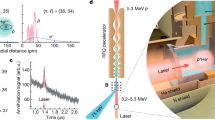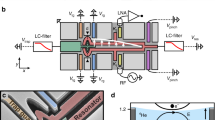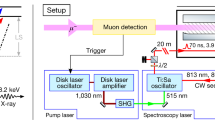Abstract
Improvements in both theory and frequency metrology of few-electron systems such as hydrogen and helium have enabled increasingly sensitive tests of quantum electrodynamics, as well as ever more accurate determinations of fundamental constants and the size of the nucleus. At the same time, advances in cooling and trapping of neutral atoms have revolutionized the development of increasingly accurate atomic clocks. Here, we combine these fields to reach very high precision on an optical transition in the helium atom by employing a 4He Bose–Einstein condensate confined in a magic wavelength optical dipole trap. The measured transition accurately connects the ortho- and parastates of helium and constitutes a stringent test of quantum electrodynamics theory. In addition, we test polarizability calculations and ultracold scattering properties of the helium atom. Finally, our measurement lays the foundation for a determination of the 3He–4He nuclear charge radius difference with an accuracy exceeding that of muonic helium measurements currently being performed in the context of the proton radius puzzle.
This is a preview of subscription content, access via your institution
Access options
Access Nature and 54 other Nature Portfolio journals
Get Nature+, our best-value online-access subscription
$29.99 / 30 days
cancel any time
Subscribe to this journal
Receive 12 print issues and online access
$209.00 per year
only $17.42 per issue
Buy this article
- Purchase on Springer Link
- Instant access to full article PDF
Prices may be subject to local taxes which are calculated during checkout




Similar content being viewed by others
References
Parthey, C. G. et al. Improved measurement of the hydrogen 1S–2S transition frequency. Phys. Rev. Lett. 107, 203001 (2011).
Pachucki, K., Patkóš, V. & Yerokhin, V. A. Testing fundamental interactions on the helium atom. Phys. Rev. A. 92, 062510 (2017).
Mohr, P. J., Taylor, B. N. & Newell, D. B. CODATA recommended values of the fundamental physical constants: 2014. Rev. Mod. Phys. 88, 035009 (2016).
Hanneke, D., Fogwell, S. & Gabrielse, G. New measurement of the electron magnetic moment and the fine structure constant. Phys. Rev. Lett. 100, 120801 (2008).
Biraben, F. Spectroscopy of atomic hydrogen. How is the Rydberg constant determined? Eur. Phys. J. Spec. Top. 172, 109–119 (2009).
Sturm, S. et al. High-precision measurement of the atomic mass of the electron. Nature 506, 467–470 (2014).
Pohl, R. et al. The size of the proton. Nature 466, 213–216 (2010).
Antognini, A. et al. Proton structure from the measurement of 2S–2P transition frequencies of muonic hydrogen. Science 339, 417–420 (2013).
Beyer, A. et al. The Rydberg constant and proton size from atomic hydrogen. Science 358, 79–85 (2017).
Fleurbaey, H. et al. New measurement of the 1S–3S transition frequency of hydrogen: contribution to the proton charge radius puzzle. Phys. Rev. Lett. 120, 183001 (2018).
Pohl, R. et al. Laser spectroscopy of muonic deuterium. Science 353, 669–673 (2016).
Nebel, T. et al. The Lamb-shift experiment in muonic helium. Hyperfine Interact. 212, 195–201 (2012).
Kandula, D. Z., Gohle, C., Pinkert, T. J., Ubachs, W. M. G. & Eikema, K. S. E. Extreme ultraviolet frequency comb metrology. Phys. Rev. Lett. 105, 063001 (2010).
Hodgman, S. S. et al. Metastable helium: A new determination of the longest atomic excited-state lifetime. Phys. Rev. Lett. 103, 053002 (2009).
Cancio Pastor, P. et al. Absolute frequency measurements of the 2 3 S 1 → 2 3 P 0,1,2 atomic helium transitions around 1083 nm. Phys. Rev. Lett. 92, 023001 (2004).
Luo, P.-L., Peng, J.-L., Shy, J.-L. & Wang, L.-B. Precision frequency metrology of helium 2 1 S 0 → 2 1 P 1 transition. Phys. Rev. Lett. 111, 013002 (2013).
Notermans, R. P. M. J. W. & Vassen, W. High-precision spectroscopy of the forbidden 2 3 S 1 → 2 1 P 1 transition in quantum degenerate metastable helium. Phys. Rev. Lett. 112, 253002 (2014).
Luo, P.-L. et al. Precision frequency measurements of 3,4He 2 3 P → 3 3 D transitions at 588 nm. Phys. Rev. A. 94, 062507 (2016).
Zheng, X. et al. Measurement of the frequency of the 2 3 S−2 3 P transition of 4He. Phys. Rev. Lett. 119, 263002 (2017).
Huang, Y.-J. et al. Frequency measurement of the 2 1 S 0−3 1 D 2 two-photon transition in atomic 4He. Phys. Rev. A. 97, 032516 (2018).
Borbely, J. S. et al. Separated oscillatory-field microwave measurement of the 2 3 P 1−2 3 P 2 fine-structure interval of atomic helium. Phys. Rev. A. 79, 060503(R) (2009).
Smiciklas, M. & Shiner, D. Determination of the fine structure constant using helium fine structure. Phys. Rev. Lett. 105, 123001 (2010).
Zheng, X. et al. Laser spectroscopy of the fine-structure splitting in the 2 3 P J levels of 4He. Phys. Rev. Lett. 118, 063001 (2017).
Marsman, A., Horbatsch, M. & Hessels, E. A. Quantum interference effects in saturated absorption spectroscopy of n = 2 triplet helium fine structure. Phys. Rev. A. 91, 062506 (2015).
Wang, L.-B. et al. Laser spectroscopic determination of the 6He nuclear charge radius. Phys. Rev. Lett. 93, 142501 (2004).
Mueller, P. et al. Nuclear charge radius of 8He. Phys. Rev. Lett. 99, 252501 (2007).
Shiner, D., Dixson, R. & Vedantham, V. Three-nucleon charge radius: A precise laser determination using 3He. Phys. Rev. Lett. 74, 3553–3556 (1995).
Cancio Pastor, P. et al. Frequency metrology of helium around 1083 nm and determination of the nuclear charge radius. Phys. Rev. Lett. 108, 143001 (2012).
van Rooij, R. et al. Frequency metrology in quantum degenerate helium: Direct measurement of the 2 3 S 1 → 2 1 S 0 transition. Science 333, 196–198 (2011).
Sick, I. Zemach moments of 3He and 4He. Phys. Rev. C. 90, 064002 (2014).
Notermans, R. P. M. J. W., Rengelink, R. J., van Leeuwen, K. A. H. & Vassen, W. Magic wavelengths for the 2 3 S → 2 1 S transition in helium. Phys. Rev. A. 90, 052508 (2014).
Campbell, S. L. et al. A Fermi-degenerate three-dimensional optical lattice clock. Science 358, 90–94 (2017).
Marti, G. E. et al. Imaging optical frequencies with 100 μHz precision and 1.1 μm resolution. Phys. Rev. Lett. 120, 103201 (2018).
Ludlow, A., Boyd, M. M., Ye, J., Peik, E. & Schmidt, P. Optical atomic clocks. Rev. Mod. Phys. 87, 637–701 (2015).
Mitroy, J. & Tang, L.-Y. Tune-out wavelengths for metastable helium. Phys. Rev. A. 88, 052515 (2013).
Zhang, Y.-H., Tang, L.-Y., Zhang, X.-Z. & Shi, T.-Y. Tune-out wavelength around 413 nm for the helium 2 3 S 1 state including relativistic and finite-nuclear-mass corrections. Phys. Rev. A. 93, 052516 (2016).
Henson, B. M. et al. Precision measurement for metastable helium atoms of the 413 nm tune-out wavelength at which the atomic polarizability vanishes. Phys. Rev. Lett. 115, 043004 (2015).
Wu, F.-F. et al. Relativistic full-configuration-interaction calculations of magic wavelengths for the 2 3 S 1 → 2 1 S 0 transition of helium isotopes. Preprint at https://arXiv.org/abs/1804.01218 (2018).
Fried, D. G. et al. Bose–Einstein condensation of atomic hydrogen. Phys. Rev. Lett. 81, 3811–3814 (1998).
Killian, T. C. et al. Cold collision frequency shift of the 1S–2S transition in hydrogen. Phys. Rev. Lett. 81, 3807–3810 (1998).
Killian, T. C. 1S–2S spectrum of a hydrogen Bose–Einstein condensate. Phys. Rev. A. 61, 033611 (2000).
Notermans, R. P. M. J. W., Rengelink, R. J. & Vassen, W. Comparison of spectral linewidths for quantum degenerate bosons and fermions. Phys. Rev. Lett. 117, 213001 (2016).
Vassen, W. et al. Cold and trapped metastable noble gases. Rev. Mod. Phys. 84, 175–210 (2012).
Rengelink, R. J., Notermans, R. P. M. J. W. & Vassen, W. A simple 2 W continuous-wave laser system for trapping ultracold metastable helium atoms at the 319.8 nm magic wavelength. Appl. Phys. B 122, 122 (2016).
Moal, S. et al. Accurate determination of the scattering length of metastable helium atoms using dark resonances between atoms and exotic molecules. Phys. Rev. Lett. 96, 023203 (2006).
Müller, M. W. et al. Experimental and theoretical studies of the Bi-excited collision systems He* (2 3 S) + He*(2 3 S, 2 1 S) at thermal and subthermal kinetic energies. Z. Phys. D 21, 89–112 (1991).
Morton, D. C., Wu, Q. & Drake, G. W. F. Energy levels for the stable isotopes of atomic helium (4He I and 3He I). Can. J. Phys. 84, 83–105 (2006).
Diepold, M. et al. Theory of the Lamb shift and fine structure in muonic 4He ions and the muonic 3He–4He isotope shift. Preprint at https://arXiv.org/abs/1606.05231v2 (2017).
Borbely, J. S., van Rooij, R., Knoop, S. & Vassen, W. Magnetic-field-dependent trap loss of ultracold metastable helium. Phys. Rev. A. 85, 022706 (2012).
Grimm, R., Weidemüller, M. & Ovchinnikov, Y. B. Optical dipole traps for neutral atoms. Adv. At. Mol. Opt. Phys. 42, 95–170 (2000).
Circular T bulletins 358–360 BIPM https://www.bipm.org/en/bipm-services/timescales/time-ftp/Circular-T.html (2017).
Acknowledgements
We would like to thank R. van der Beek for useful discussions and a critical reading of the manuscript, D. Cocks and I. Whittingham for helpful discussions, and R. Kortekaas for technical support. We gratefully acknowledge financial support from the Netherlands Organisation for Scientific Research (NWO).
Author information
Authors and Affiliations
Contributions
R.J.R. and R.P.M.J.W.N. constructed the experimental set-up. R.J.R., Y.v.d.W. and M.D.H. performed the measurements. R.J.R., Y.v.d.W. and R.J. investigated systematic effects. R.J.R. performed the data analysis. R.J.R., R.P.M.J.W.N. and K.S.E.E. performed and discussed the frequency metrology. W.V. initiated and supervised the project. All authors discussed the results and contributed to the manuscript.
Corresponding author
Ethics declarations
Competing interests
The authors declare no competing interests.
Additional information
Publisher’s note: Springer Nature remains neutral with regard to jurisdictional claims in published maps and institutional affiliations.
Supplementary information
Supplementary Information
Supplementary Text, Figures S1, Table S1, and References
Rights and permissions
About this article
Cite this article
Rengelink, R.J., van der Werf, Y., Notermans, R.P.M.J.W. et al. Precision spectroscopy of helium in a magic wavelength optical dipole trap. Nature Phys 14, 1132–1137 (2018). https://doi.org/10.1038/s41567-018-0242-5
Received:
Accepted:
Published:
Issue Date:
DOI: https://doi.org/10.1038/s41567-018-0242-5
This article is cited by
-
Testing quantum electrodynamics in extreme fields using helium-like uranium
Nature (2024)
-
Pauli blocking of stimulated emission in a degenerate Fermi gas
Nature Communications (2022)
-
Measuring the α-particle charge radius with muonic helium-4 ions
Nature (2021)
-
The proton size
Nature Reviews Physics (2020)
-
Precise test of quantum electrodynamics and determination of fundamental constants with HD+ ions
Nature (2020)



